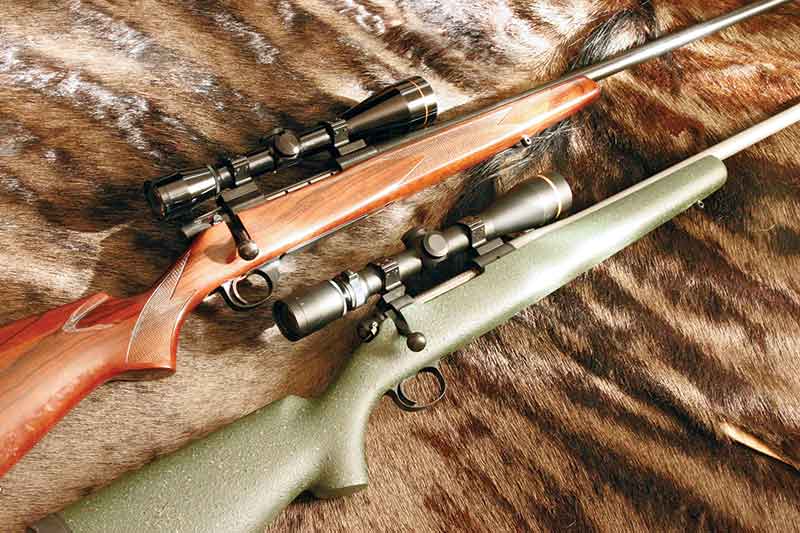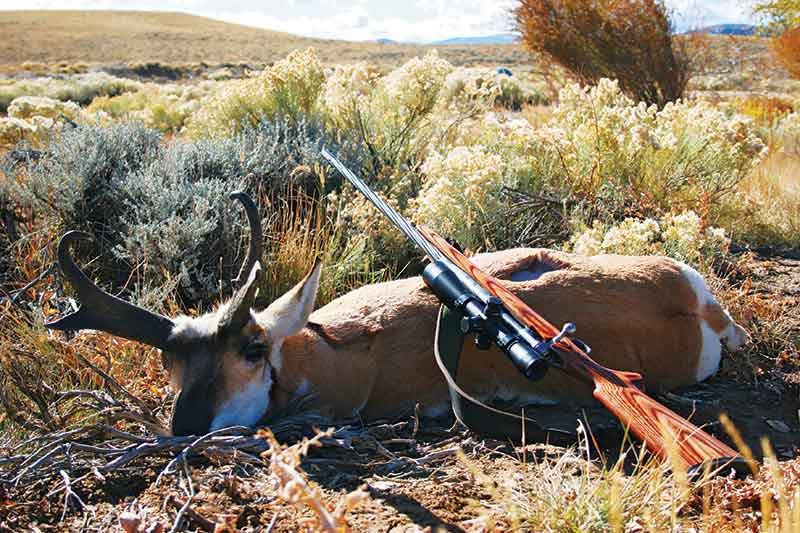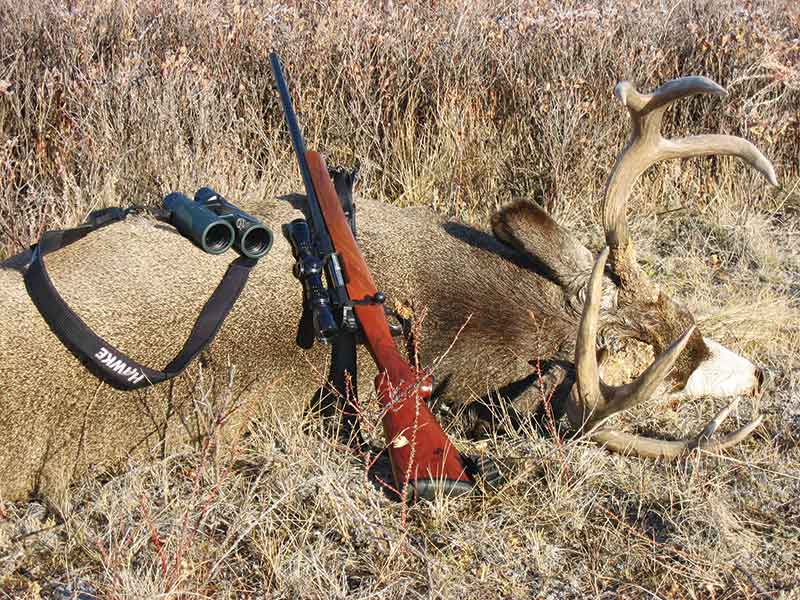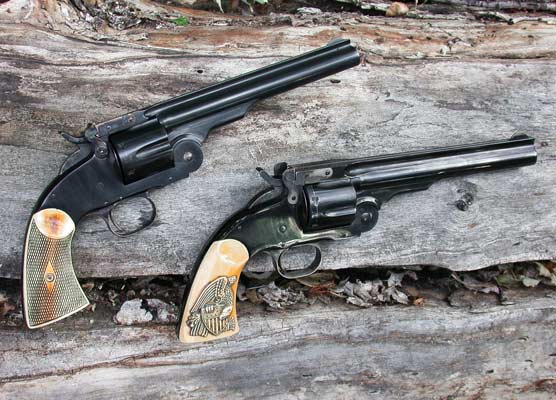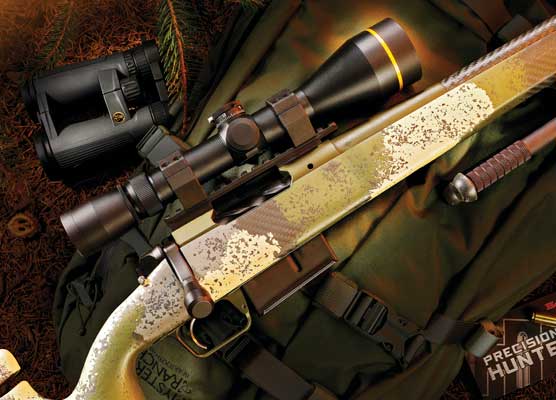Tool Vs. Elegance
Synthetic Stocks Don’t Always Mean “Utilitarian Ugly.”
Walnut Ones Don’t Always Need Babying.
Shooters have widely differing notions about whether guns should be regarded as tools (like hammers or lawn mowers) or whether some elegance and even embellishment is entirely appropriate. Many will even argue the point, sometimes almost as angrily—or condescendingly—as with politics. Part of the problem (if we consider this a real problem) is human nature is often contradictory. Even if some people firmly believe guns are tools, their belief often involves esthetic judgments.
A few years ago a young sub-editor for a hunting magazine went on a guided hunt in Alaska, using a rifle on loan from one of the magazine’s advertisers, with a synthetic stock and stainless-steel barreled action, supposedly ideal for Alaska’s rugged weather and terrain. The editor hunted with an outfitter, staying in a camp with several other clients and guides.
When the hunt began he was very careful with the loaner rifle, which the outfitter and his guide quickly noticed. They started poking fun of his gentle treatment of the rifle, whereupon he noticed their rifles were missing much of their finish, and even small chunks of their stocks. The Alaskans seemed to take some pride in their battered “hammers,” so he became more lax with his loaner.
After returning home he brought the rifle to the publishing office so it could be shipped back to the manufacturer, also exhibiting some pride in its battered exterior. Far from being impressed, his boss told the young editor the rifle would not be returned to the manufacturer in that condition. Instead the publishing company would buy it, and the price would come out of the young editor’s paycheck.
This is not a judgment. Instead it’s a simple observation some degree of esthetics enters into most human choices, even rifle abuse, and esthetic values are often formed by social forces. To Alaskans who take pride in the battered appearance of their “hammers,” the scars on their rifles are not just well-earned merit badges, but a testament to their way of life—like a safe full of custom rifles stocked in fine walnut owned by a successful businessman.
I own both kinds of rifles and hunt with both. Partly this is because of my job, but partly it’s due to growing up when hardwood stocks and blued steel were simply what rifles were made of. Most reviews of new rifles commented on the quality of their hardwood stocks, especially whether the pores in the wood were “properly filled” rather than appearing like tiny woodpecker wounds, or the checkering had overruns around the edges, or all the diamonds were properly pointed-up rather than flat-topped.
I also remember my father’s horror when our neighbor across the alley (one of his co-workers and a good friend) purchased a Remington Nylon 66 .22 autoloader with a “plastic” stock. The same neighbor helped me “sporterize” my first centerfire rifle, a Mosin-Nagant purchased with $10 of paper-route money. After cutting down the stock and barrel, I sanded the dents out of the wood and announced my decision to paint it dark brown, since the pale wood (probably birch) had less character than the linoleum floor in our kitchen. But my father said, “Nobody paints gun stocks,” so I used furniture finish including a “walnut” stain. As a result the stock looked like stained birch with tiny woodpecker wounds. I wonder what he’d think of the paint jobs on today’s synthetic stocks, whether digital camo or paint-splatters resembling the abstract art of Jackson Pollock. (Of course, many shooters who own such stocks would never own an abstract painting, instead preferring realistic renditions of bugling elk.)
Transitional Era
The synthetic/stainless revolution really started rolling during the 1980’s, and nowadays some hunters refuse to buy a rifle with a walnut stock and blued steel. Yet some still admit they’d like to own a rifle with a really nice walnut stock, if only they weren’t afraid of scratching it while wandering around The Great Outdoors. I suspect some of this fear arises from what might be termed the transitional era between “classic” walnut/blue and “modern” synthetic/stainless rifles.
Until the middle of the 20th century, many if not most walnut stocks were finished in natural oil such as linseed or tung, though stocks of paler wood were often stained and varnished. But technological advances, primarily made during the years around World War II, soon transformed many products. Among these was polyurethane, originally developed as a substitute for rubber during the war. Among a zillion other uses, polyurethane became a gun stock finish, because it was easily applied and far more weatherproof than any purely organic oil.
Soon many factory stocks wore a substantial layer of polyurethane, but because the finish was “plastic” it tended to chip, especially in cooler weather. The old-style finishes could be easily touched up with a thin layer of linseed oil, from a can purchased cheaply at the nearest hardware store, but the only real solution for chipped and scratched polyurethane was removal and refinishing.
In fact that’s what some traditionalists did. Removing the factory finish and re-sanding the stock also usually removed another modern touch, impressed “checkering,” itself usually semi-filled with polyurethane. Some hunters, like Alaskans, just left their plastic-coated stocks chipped and scratched. In the mid-1970’s one of my older Montana friends bought an impressed-checkered Remington 700 ADL and within a couple of years it looked like it had been dragged behind his pickup on a gravel road. I made the mistake of suggesting how to refinish the stock, and he sneered, “I don’t care about that.”
But really good walnut stocks, the kind made by custom practitioners of the art such as D’Arcy Echols, are much better at resisting nature. First, such stocks are usually made of exceptionally dense walnut, often the European species, far harder than the plain-grained black walnut used in most factory stocks. They’re also usually finished with modern spar varnish, a blend of organic oil and polyurethane. The very thin finish is actually in the wood, rather than sitting on top like petrified Saran Wrap. The oils allow each coating to bind tightly to the previous layer, the polyurethane resists water, and any scratch can be easily obscured with another very thin application of spar varnish. (Echols, by the way, also makes synthetic-stocked rifles with a proprietary pattern from McMillan.)
This is actually easier than repairing the paint job on many synthetic stocks, though of course many users of synthetic stocks don’t care about that, either. But some obviously do, or they wouldn’t bother with fancy paint jobs in the first place. And even some stocks painted in Henry Ford’s original “color” choice on the Model T (black) can benefit from easy repair. The black Kevlar/epoxy stock of my 20-year-old New Ultra Light Arms .30-06 was finished with the brand of paint Melvin Forbes used exclusively for many years, because it was the lightest he could find.

Even traditional gun shops, like Capital Sports & Western Wear in Montana,
offer plenty of modern hunting rifles, such as this Sako TRG 22 (above). Even
in Africa a classic .470 Nitro-Express double may be involved in such inelegant
tasks as checking Cape buffalo droppings for residual warmth (below).
Yes, he actually weighed layers of paint, because the entire point when he started making Ultra Lights in 1985 was the lightest possible hunting rifle. But the paint required a white primer—also very lightweight—to stick to the epoxy, and like polyurethane the primer is somewhat brittle. This is why I chose black: Any white dings can be covered up with a black Magic Marker. (I actually don’t care about that, but the dings are distracting in a photograph, where the focus should literally be on everything else, not a rifle stock appearing to have tiny white woodpecker chips. The stock also has a few Alaska-style chunks missing, also blended-in with Magic Marker.)
The metal’s covered in dark gray titanium nitride, one of the toughest finishes known, so can’t chip or rust. Here it might be appropriate to note blueing itself was originally intended as rust protection—or rather, an intentional light rust of a more attractive color, to prevent deeper red rusting. Blueing does resist red rust to a certain extent, but in really wet weather requires extra protection, the reason more effective methods of finishing chrome-moly steel were developed.
My other NULA rifle was made a decade later, after Melvin started using a slightly heavier but more flexible paint now offered as an option. This rifle’s a stainless-barreled .257 Weatherby, its dull green stock embellished by tiny Jackson Pollock-style black and yellow splatters, and hasn’t chipped at all. The barrel’s also stainless steel, so wasn’t finished except for bead-blasting.
Both rifles are among my hammers, partly because I’ve yet to encounter a NULA rifle that doesn’t cling to its zero like an osprey clings to a dead trout. Aside from very stiff yet light stocks, they’re bedded in an epoxy often used in the aerospace industry, and the scope rings don’t attach to bases, instead screwing directly onto the receiver.
Both rifles also have scopes without elevation turrets easily twirled in the field. Such scopes, of course, are going out of style. Several of my other hunting rifles have turret-twisting scopes, but until somebody develops one absolutely reliable weighing 12 ounces (so a certain 60-something Montana hunter can pack his very light rifles up steep Montana slopes), then old-fashioned scopes will remain in place. They’ve worked fine out to 500 yards, using the reticles as longer-range aiming points. (Before someone points out—and they always do—that a lighter weight rifle doesn’t make near as much difference as a lighter weight body, I have also lost meaningful weight since turning 60, and trimmed excess weight from my hunting clothing and pack, which was partly full of duplicate or useless stuff. Between trimming gear and myself, my uphill load is now 20-some pounds lighter—but for some odd reason gaining elevation still isn’t as easy as it was even a decade ago.)
I’ve taken more animals with the NULA .30-06 than any other over the past two decades, but my next most-used big game rifle is a “modern classic” version of the same general idea, a Kilimanjaro Rifles Walkabout 7×57 on a Montana 1999 action, a cross between the pre-’64 Model 70 and 98 Mauser. Its fancy walnut stock is actually a 3-layer laminate, but because the inside layer is sliced from the same stock blank most people can’t even see the lamination unless it’s pointed out. The steel appears matte-blued, but is really dark Cerakote, a ceramic-based finish not quite as tough as titanium nitride, so it even wears slightly at the “corners” like blueing. The barrel is stainless under the coating, and since the scope mounts are the same as the NULA’s it also retains zero extremely well.
I eventually had Kilimanjaro stock one of my other rifles in even fancier wood, and by some odd coincidence the barreled action’s also a controlled-round-feed with a hinged steel floorplate, a CZ 550 in 9.3×62.
One interesting thing about hunting rifles, whether tool or elegant, is in the half-century or so since sporterizing my old Mosin-Nagant the list of “must haves” has changed considerably but remains just as rigid. Back then the snob’s hunting rifle had to be a controlled-round-feed action, usually a pre-’64 Winchester Model 70 or 98 Mauser, with an all-steel, hinged floorplate, a checkered walnut stock proportioned to be useful from any shooting position and a simple scope in light but rugged rings. The cartridge also needed to be traditional, something from the .250-3000 to the .375 H&H, though the 7mm Remington Magnum was already becoming a tradition.
New Cutting Edge
Today the cutting-edge hunting rifle must have a “lay-up” synthetic stock, not a cheap “Tupperware” injection-molded model, though some hunters are now going to so-called chassis stocks, with adjustable cheekpieces and length-of-pull, plus screw holes and rails to attach gadgets such as bipods and flashlights. The scope must be a 30mm-tubed variable with an uncovered elevation turret, in tactical mounts on a Picatinny rail. (I don’t know how we ever mounted scopes securely before rails.)
The action should be a custom “700 footprint” push-feed, with a detachable magazine and an over-sized bolt handle, so we can run the bolt while lying on our bellies and retaining the proper cheek-weld. The chambering should be a short-action round without a belt, though once in a while a .280 Ackley Improved or .338 Lapua is acceptable. Ideally the rifle should be finished in some sort of camouflage, so even if we’re wandering around the wilderness wearing orange our rifle remains invisible. (Hey, I’m laughing with you, since my hunting rifles include several examples of both.)
But probably the primary must-have is a synthetic stock. Or maybe not. Even synthetic stocks warp, though due to heat rather than moisture. Many cutting-edge hunters replace injection-molded stocks with much more expensive fiber/epoxy lay-ups, but on occasion I’ve replaced “Tupperware” with walnut. Many nice factory-made walnut stocks can be purchased inexpensively second-hand, because their owners replaced them with lay-up synthetics, but wood is still stiffer than injection-molded polymers. And today’s factory walnut stocks actually have nice checkering, thanks to the miracles of modern manufacturing.
You can also buy synthetic stocks supposedly resembling wood-grain, which also says something about the human psyche, though exactly what is hard to tell.
D’Arcy Echols & Co.
98 W 300 S, Millville
UT 84326
(435) 755-6842
www.echolsrifles.com
E.R. Shaw Custom Barrels
5312 Thoms Run Rd.
Bridgeville, PA 15017
(412) 221-3636
www.ershawbarrels.com
Kilimanjaro Rifles
707 Richards Street, Suite 201
Honolulu, HI 96813
(877) 351-4440
www.kilimanjarorifles.com
New Ultra Light Arms
P.O. Box 340
Granville, WV 26534
(304) 292-0600
www.newultralight.com
